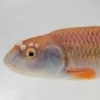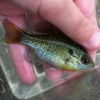
Tank size Elassoma okefenokee
#1

Posted 03 October 2017 - 10:08 PM
Thank you
Also do they eat pond snails?
#2

Posted 04 October 2017 - 12:25 PM
When you do go that way, you need to figure out how to simulate a steam bank wall. They seem to associate with the bottom or at least structure and you don't want to lose the vertical space and only have fish on the bottom.
Regards snails; my reading says they eat snail eggs and that jives with my experience (although I can't say I have ever observed the act)
#3

Posted 04 October 2017 - 09:39 PM
Ok sounds good. So 4 and 3 in 10 gallons? Question. How do you catch these guys without uprooting all your plants?I would stay with the two 10s for a while. If you get both of those going nicely then I think a corner tank would be fun for a larger group, but right now they would just get lost (visually).
When you do go that way, you need to figure out how to simulate a steam bank wall. They seem to associate with the bottom or at least structure and you don't want to lose the vertical space and only have fish on the bottom.
Regards snails; my reading says they eat snail eggs and that jives with my experience (although I can't say I have ever observed the act)
Also, something like this but underwater?[attachment=18987:1004171400_HDR-1.jpg]
#4

Posted 05 October 2017 - 02:33 PM
Ahhh ... so you have discovered the inherent tension between aquascaping and fish breeding. Two nets: one larger (hold it still to catch fish) and a small one (or hand, stick, etc) to coax them toward the stationary net. And lots of patience. Those of us who are more breeders than aquascapers either use non-rooted plants, or put rooted plants in containers that are removable.
Ok sounds good. So 4 and 3 in 10 gallons? Question. How do you catch these guys without uprooting all your plants?
Also, something like this but underwater?
Gerald Pottern
-----------------------
Hangin' on the Neuse
"Taxonomy is the diaper used to organize the mess of evolution into discrete packages" - M.Sandel
#5

Posted 05 October 2017 - 11:49 PM
well that sucked big time! I think I destroyed half my tank! I never wanna do it again! Any chance fry can survive without moving parents?Ahhh ... so you have discovered the inherent tension between aquascaping and fish breeding. Two nets: one larger (hold it still to catch fish) and a small one (or hand, stick, etc) to coax them toward the stationary net. And lots of patience. Those of us who are more breeders than aquascapers either use non-rooted plants, or put rooted plants in containers that are removable.
#6

Posted 06 October 2017 - 08:07 AM
Yes, as long as they get enough food, they can grow up with the parents. What i've found is that older siblings are a bigger problem than the parents: Juvenile fish starting to get territorial instincts like to "practice" on their younger brothers and sisters. Also, males grow faster and are more assertive than females, so if there's not enough food you might end up with fewer females. Feeding fresh-hatched brine shrimp daily (once they're big enough to eat it, about 2 weeks) usually avoids that problem.
Gerald Pottern
-----------------------
Hangin' on the Neuse
"Taxonomy is the diaper used to organize the mess of evolution into discrete packages" - M.Sandel
#7

Posted 06 October 2017 - 11:38 AM
Yes, as long as they get enough food, they can grow up with the parents. What i've found is that older siblings are a bigger problem than the parents: Juvenile fish starting to get territorial instincts like to "practice" on their younger brothers and sisters. Also, males grow faster and are more assertive than females, so if there's not enough food you might end up with fewer females. Feeding fresh-hatched brine shrimp daily (once they're big enough to eat it, about 2 weeks) usually avoids that problem.
Thanks for the reply. I still don't have a hatchery but I have fresh banana worms, black worms, white worms and frozen mini blood worms, blood worms, daphnia, baby brine and brine. So far I don't see any real response to the frozen stuff but they always have live food in there So it could be accountable to that. I have been cutting the white worms to about a quarter inch. I would like to do that in house hatchery I saw on one of Erica's threads but I don't think they would fit in a 10g. I have some rainbow fish I've spent almost 200 bucks on meds for columnaris and they still haven't fully recovered so my funds are limited for a bit :/
Some of the banana worms get Arnold sized tho it seems??
Edited by Cricket, 06 October 2017 - 11:40 AM.
#8

Posted 09 October 2017 - 12:09 AM
Fish traps, my friend!
Cut the top third off a plastic bottle, take the lid off, and cram the top into the bottle upside-down so it makes a funnel pointing into the bottle. Tie a string around it, put tempting food inside, poke a few holes in it, sink it to the bottom of the tank so it's lying on its side, and keep an eye on it. Fish go in, but they can't get out, and you can gently pull it out by the string, quickly place the bottle in a bucket, pull the top back out, and dump out the fish. Honestly not certain if it'll work with fry, but juveniles should go in.
In the meantime, lots of moss and other small-leafed, tightly-packed plants should give good hiding spaces for fry. Throw in some oak leaves to add tannins and provide extra food for microorganisms, and you're in a good position to have some fry survive in the tank.
#9

Posted 09 October 2017 - 02:50 PM
Thank you. Maybe I'll try that my next go around.Fish traps, my friend!
Cut the top third off a plastic bottle, take the lid off, and cram the top into the bottle upside-down so it makes a funnel pointing into the bottle. Tie a string around it, put tempting food inside, poke a few holes in it, sink it to the bottom of the tank so it's lying on its side, and keep an eye on it. Fish go in, but they can't get out, and you can gently pull it out by the string, quickly place the bottle in a bucket, pull the top back out, and dump out the fish. Honestly not certain if it'll work with fry, but juveniles should go in.
In the meantime, lots of moss and other small-leafed, tightly-packed plants should give good hiding spaces for fry. Throw in some oak leaves to add tannins and provide extra food for microorganisms, and you're in a good position to have some fry survive in the tank.
1 user(s) are reading this topic
0 members, 1 guests, 0 anonymous users










